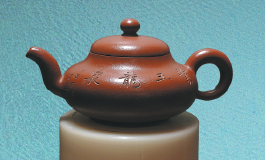Turning the simple teapot into an iconic masterpiece
A pair of young apprentices concentrate their attention on shaping a teapot on a potter's wheel, with the aid of simple tools, like a small knife. They are learning to craft Chaozhou handmade red-clay teapots at a studio founded by Xie Hua, a national-level inheritor of the intangible heritage originating from Chaozhou, Guangdong province.
Xie, now in his 50s, was born into a teapot-making family, the owner of a major local time-honored brand in the trade. He is a fifth-generation inheritor of the craft in his family business called Junhe, which means a gathering of talent.
Immersed in crafting pottery for more than three decades, Xie has established himself as a leader in the trade. Yet the master said one of his principles is to keep a critical eye on his own works in a bid to make continuous improvements and then, keep learning and be inspired by other artworks.
Paired with gongfu tea, a local tea ritual, the Chaozhou handmade teapot has a centuries-old history.
The pot is mainly made of unique red clay, which falls into the category of zisha earth materials. It is more difficult to use the red clay to make a teapot because it has a contraction rate of up to more than 20 percent, far higher than the average of around 15 percent among zisha. As a result, there is a lower pass-yield rate after firing, according to Xie.

Chaozhou handmade teapot. CHINA DAILY
Despite the challenges, red clay is preferred among more than 100 types of clay that could be used to craft Chaozhou teapots. This is because it has a lower water absorption rate which means the tea brewed in such pots tastes better. Thus, the Chaozhou pot is a perfect match for gongfu tea, he said.
While inheriting traditional skills, Xie has innovated with clay materials and production technologies, turning the Chaozhou teapot from just a utensil to something combining aesthetic appeal and functional value. "There are multifaceted criteria to judge whether a teapot is of high quality, such as clay materials, craft, design, utility and durability," he said.
Xie said his goals have varied in different stages of his career. His current focus is to make teapots come alive and exude an eternal charm. "A really good teapot will become a work of artistic merit and can affect people' emotions," he said. "The more you look at it, the more you love it."
Many of his works have won national awards and have been collected by top-tier venues, including the National Museum of China and Diaoyutai State Guesthouse.
Traditionally, craftsmen tended to keep their know-how within their family, but Xie is open about his expertise. He has offered training for more than 10 years, benefiting hundreds of people.
He noted: "The younger generation matters in the inheritance of intangible cultural heritage."
Handmade teapots
Made of local clay, one of its major raw materials, handmade teapots from Chaozhou are made using traditional pottery-making methods, centering the prepared clay on the wheel and crafting it by hand with the aid of manual tools. It goes through nearly 60 production processes for a teapot to be completed, including sourcing and preparing the clay, shaping and refining the pot, glazing and firing. The pottery formed its own style during the mid-Qing Dynasty (1644-1911) and has been passed down for generations. It was included on the fourth list of national intangible cultural heritage in 2014. Finished Chaozhou handmade teapots feature exquisite designs, succinct lines, rich colors and a high degree of smoothness. In an elegant style, they combine functional and aesthetic value.



 Print
Print Mail
Mail

